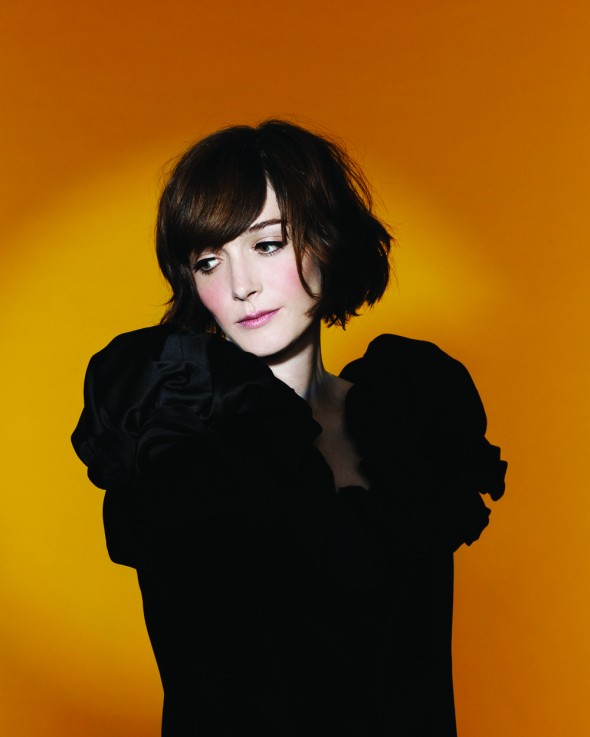
Australian singer Sarah Blasko is an unlikely pop star. Her confessional songs are full of complicated feelings and tangled emotions, and her subtle vocal style owes as much to jazz and gospel singers as it does to any current diva. She croons her dreamy lyrics in a breathy voice, coming in before or after the beat to give the songs a delicious, indecisive tension that draws you into her world with a gentle insistent grace. On stage, she’s almost as quiet as she is on record, whispering to the crowd while her band embroiders her tunes with restrained electric guitars and subliminal percussion accents. “Less is more,” Blasko says from the New York office of her American publicist. “That’s the main idea that occurred to me when I was writing this album.”
The album is As Day Follows Night, her third solo effort, and the first to be getting a big promotional push in the United States. Her first two records, The Overture & the Underscore, which was a platinum success in Australia, and the ARIA (Australian Grammy) winning What the Sea Wants, the Sea Will Have, were both released in the US, but didn’t get much play from critics or radio. “I toured [the US] a bit when they came out, but I didn’t put much work into promoting them, really.”
As Day Follows Night is a radical departure from Blasko’s previous efforts. The instruments are all acoustic and it’s the first record that she hasn’t co-produced herself. Instead, she enlisted the help of Björn Yttling [of Peter Bjorn and John] who corralled some of Sweden’s top jazz players and held sessions in the same studio that ABBA used to turn out all those hits. “It’s a huge studio and it was a bit intimidating at first,” Blasko says. “But it’s a warm room, not at all sterile and everybody was really supportive. When Janne Hansson, one of the engineers, would hear a take he really liked, he’d get all teary, which was really encouraging.”
The songs on the album were written after Blasko broke up with her long time musical and personal partner Robert Cranny. “It is a heartbreak album, but it’s also hopeful. I didn’t want it to be a long wallow. There are a lot of sad songs, but in the process of recording them, they took on a more positive aspect.” Blasko poured her hopes and dreams into the songs on the album, believing in the ability of music to transform her emotions into uplifting sentiments. She believes that even the saddest song is an act of faith that things will get better.
Blasko wrote As Day Follows Night on the piano, instead of guitar. She’d sit and play random notes on the keyboard until a song began to take shape. In her teen years, her parents belonged to a Pentecostal church. There was always a section of the service dedicated to free singing where the band improvised and the singers poured out their hearts. That experience stayed with her when she started writing songs. “I still write in a similar way. That spirit is with me all the time. If I just start singing, it usually comes out.”
Since the songs that make up As Day Follows Night were composed in a creative frenzy, she wanted to bring in someone who could see them with fresh eyes. Yttling accents his productions with inventive rhythm and percussion touches, which complimented Blasko’s more melodic approach. “We inspired each other,” Blasko said.
During the recording process, Blasko and Yttling played each other songs by artists they liked: Talking Heads, Paul McCartney, Leonard Cohen and Paul Simon. The idea was to create arrangements that embraced all kinds of music. “Some songwriters want to give the impression that they live on a remote musical island, as if they’re ashamed to admit they have influences,” Blasko states. “We wanted to embrace our influences. That’s why we used a Talking Heads rhythm on ‘Over & Over’ and called a song ‘Bird On A Wire’ after Leonard Cohen.”
Blasko said that borrowing ideas and making them your own, makes the music richer. “Acknowledging other artists helps connect you to the river of songs that we’re all carried along by.” Blasko likes the fact that pop can range through so many styles: jazz, blues and folk. “I want to embrace them all,” she says.
One thing Blasko hasn’t embraced, at least not yet, is rock in its rowdier incarnation. Does she ever get the urge to grab the mic and kick out the jams? “I’m a big fan of subtle in music. I like emotions that are implied, the little details you don’t notice consciously can be quite mesmerizing. I like holding back and slowly revealing my secrets, but I do feel the need to explode and I’m sure I will at some point. After three quiet reflective albums, it might be time to start shouting.”
– J. Poet
photography by Chris Morris

